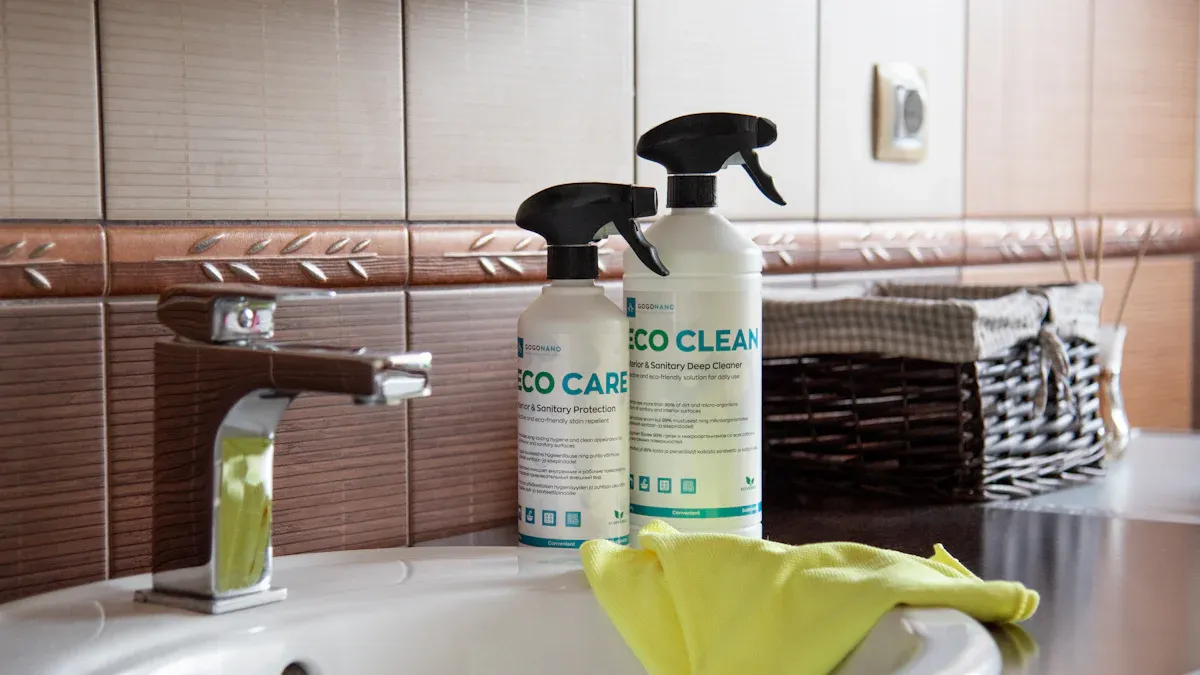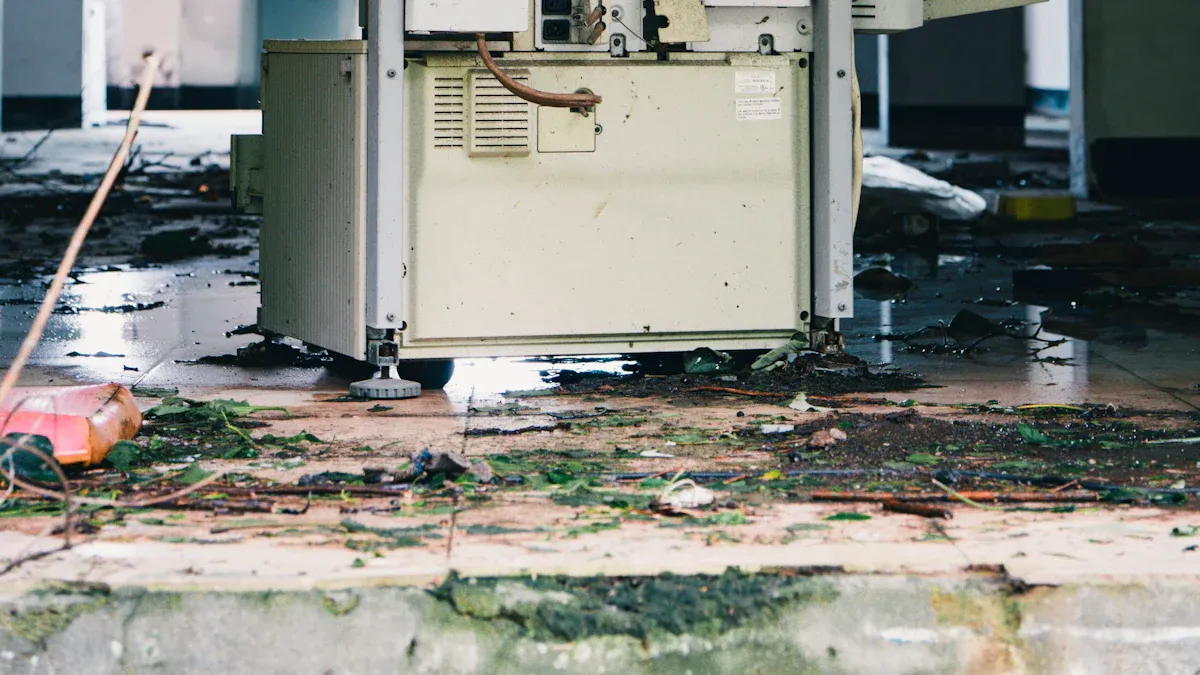
 FEEDBACK
FEEDBACK
If you are interested in our products and want to know more details, please leave a message here, we will reply you as soon as possible.


Keeping your PVC bathroom cabinets clean helps them look great and last longer. You might run into common mistakes like using harsh chemicals, scrubbing too hard, or letting water sit on the surface. These habits can cause stains, scratches, or even warping. Don’t worry—making a few simple changes can help you avoid damage and keep your cabinets looking fresh.

Cleaning PVC bathroom cabinets seems easy, but you can run into some common mistakes that damage the surface or shorten the life of your cabinets. Let’s look at the most frequent issues and how they affect your bathroom.
You might think strong cleaners work best, but harsh chemicals can ruin PVC surfaces. Products with bleach, ammonia, or strong acids break down the finish and cause discoloration. If you use these cleaners often, you may notice dull spots or faded areas. Instead, choose mild, pH-neutral cleaners. These keep your cabinets looking new and avoid chemical damage.
Tip: Always check the label before using any cleaning product. If it says “not for plastic” or “contains bleach,” skip it.
Scrubbing with rough sponges, steel wool, or scouring pads is another common mistake. These tools scratch the smooth PVC surface and leave marks that never go away. Even if you want to remove a stubborn stain, aggressive tools do more harm than good.
Tool Type | Risk Level | Result |
|---|---|---|
Steel Wool | High | Deep scratches |
Scouring Pad | Medium | Surface marks |
Soft Cloth | Low | Safe for cleaning |
Stick with soft microfiber cloths or gentle sponges. They clean well without scratching.
You might think PVC cabinets can handle all the water you throw at them. PVC is waterproof and resists daily moisture, so it’s great for bathrooms. However, leaving puddles or letting water sit for hours is a common mistake. Over time, constant humidity and heat can cause warping or make the cabinets lose strength. PVC doesn’t absorb water like wood, but it’s not as tough as plywood.
PVC cabinets resist moisture and don’t swell.
Long-term humidity and heat can cause warping or deterioration.
Regular wiping and drying help keep cabinets strong.
If water sits on the surface, mold can grow. Mold needs moisture and warmth. PVC is non-porous, so mold stays on the surface, but it still looks bad and can smell. Wipe up spills right away and keep your bathroom well-ventilated.
Scrubbing too hard is a common mistake that leads to scratches and discoloration. You might want to get rid of a stain fast, but aggressive scrubbing does more harm than good. PVC cabinets have a smooth finish, just like laminate. If you use too much force or the wrong cleaner, you’ll see dull spots or lines.
Aspect | Explanation |
|---|---|
Abrasive Tools | Scouring pads or steel wool scratch the surface. |
Aggressive Cleaning | Harsh chemicals damage the finish and cause discoloration. |
Repeated Use | Frequent rough cleaning increases the risk of permanent damage. |
Cleaning Recommendations | Use mild cleaners and soft cloths. Rinse and dry after cleaning. |
Gentle cleaning keeps your cabinets looking fresh and avoids permanent marks.
Spraying cleaner straight onto the cabinet is a quick fix, but it’s a common mistake. Liquids can drip into seams or hardware, causing sticky residue or even rust. Some cleaners leave streaks or build up over time. Instead, spray the cleaner onto a cloth first, then wipe the surface. This method gives you more control and prevents messes.
Note: Always dry the surface after cleaning. This stops water spots and keeps mold away.
By avoiding these common mistakes, you protect your PVC bathroom cabinets and keep them looking their best. Simple changes in your cleaning routine make a big difference.
When you clean your PVC bathroom cabinets, always reach for soft materials. Microfiber cloths work great because they trap dust and dirt without scratching the surface. You can use them dry for dusting or damp for wiping away smudges. Dobie pads are another good choice. They are non-abrasive and safe for delicate surfaces like PVC. If you want to be eco-friendly, reusable sponges and cloths are perfect. They last a long time, clean well, and help reduce waste.
Tip: Soft cloths and sponges come in different textures. Pick the gentlest one for your cabinets to avoid scratches.
You don’t need fancy cleaners for PVC cabinets. Mild soap and water do the job just fine. Castile Magic Soap or Sal Suds are gentle options that work on all surfaces, including PVC. Always dilute the soap and test it on a small spot first. Stay away from harsh cleaners with bleach or ammonia. These can damage the finish and make your cabinets look dull.
Use a small amount of mild soap mixed with water.
Wipe with a soft cloth or non-abrasive sponge.
Rinse with clean water and dry right away.
Spills happen, especially in the bathroom. The best thing you can do is clean them up right away. Even though PVC resists water and mold, letting moisture sit can still cause stains or warping over time. Quick cleanup keeps your cabinets looking new and stops problems before they start.
Note: Wipe up toothpaste, soap, or water spills as soon as you see them. This simple habit protects your cabinets from damage.
After you clean, make sure you dry the cabinets completely. Use a dry towel to wipe away any leftover moisture. Good airflow helps too. Turn on the bathroom fan, open a window, or leave the door open for a while. If your bathroom stays humid, try a dehumidifier or place moisture absorbers inside the cabinets. These steps keep your cabinets dry and prevent mold or water spots.
Drying Method | Benefit |
|---|---|
Towel Drying | Removes surface moisture |
Fan or Ventilation | Reduces humidity quickly |
Moisture Absorbers | Extra protection inside cabinet |
By following these best practices, you keep your PVC bathroom cabinets clean, shiny, and strong for years to come.
You want your PVC bathroom cabinets to look great for years. The best way to do this is by sticking to a regular cleaning routine. When you clean often, you stop dirt, water stains, and even mold from building up. This keeps your cabinets looking spotless and fresh. Here’s what regular cleaning does for you:
Prevents water stains, mold, and mildew from forming.
Keeps the cabinet’s surface shiny and clean.
Cuts down on expensive repairs or replacements.
Stops moisture from causing warping or discoloration.
Helps your cabinets last much longer.
Tip: Combine regular cleaning with proper drying. This simple habit protects your cabinets from moisture damage.
Trying a new cleaner? Always spot test first. This step helps you avoid surprises like stains or damage. Here’s how you can do it:
Check what your cabinets are made of and read the manufacturer’s care instructions.
Pick a small, hidden spot on your cabinet.
Apply a little bit of the new cleaner to that area.
Wait a few minutes and look for any changes in color or texture.
If nothing happens, you’re good to go!
Spot testing gives you peace of mind. You know your cabinets will stay safe, even when you try something new.
Don’t forget about the handles and hinges! These parts need care, too. Clean them with mild soap and water, and always use a soft cloth. Avoid rough pads or harsh chemicals. Here’s a simple routine:
Wipe hardware daily with a dry microfiber cloth to remove dust and fingerprints.
For deeper cleaning, use mild soap and warm water, then dry right away.
Check screws and hinges often. Tighten them if they feel loose.
Use rust-proof hardware like stainless steel or brass.
Lubricate hinges now and then to keep them moving smoothly.
Keep your bathroom dry and well-ventilated to stop rust and moisture damage.
Note: A little care goes a long way. Well-maintained hardware keeps your cabinets working and looking their best.
It might seem easy to use any cleaner you find. But it is important to follow the manufacturer's care instructions. These rules tell you how to clean your PVC bathroom cabinets safely. You can find these instructions on the cabinet maker’s website. For example, Laurysen Kitchens and Scranton Products have special care pages. They tell you which cleaning ways are safe and which products to skip. If you follow these tips, your cabinets will not get stains, scratches, or fade.
Always look at the manufacturer's website before you try a new way to clean. These care pages have the best advice for your cabinets.
Reading product labels may feel boring, but it helps you avoid mistakes. Labels tell you what is in the cleaner and how to use it right. They also warn you about dangers. If you want your cabinets to look nice, always check the label before using something new.
Here’s what you will usually see on cleaning product labels:
Chemical ingredients and common names, like bleach or ammonia
Safety warnings about fire or poison
Directions for safe and good use
Child safety warnings, like “Keep Out of the Reach of Children”
Storage tips to stop accidents
Hazard warnings for things like flammable solvents
Disposal and first aid steps
EPA numbers for disinfectants and sanitizers
Instructions in different languages or with pictures
If you see a warning or ingredient that is not safe for PVC, do not use that product. Taking a minute to read the label can save you from problems later. Your cabinets will stay in good shape!
You now know the Common Mistakes that can harm your PVC bathroom cabinets, like using harsh chemicals or letting water sit. These habits can lead to stains, scratches, or even warping. When you use soft cloths, mild soap, and keep your bathroom dry, you help your cabinets last longer. Regular cleaning stops mold and grime from building up. With these simple steps, your cabinets will stay strong and look great for years.